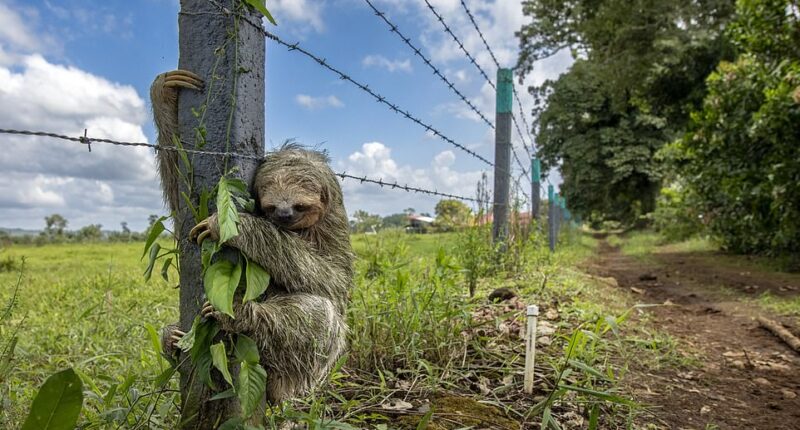Picked from more than 60,000 entries, the first images from the Natural History Museum’s wildlife photographer of the year competition have been released.
These stunning images are among the ‘highly commended’ photographs, with the winners set to be announced later this year.
Ranging from a lion facing down to a march of emperor penguins to a grouping of slime mould, the images capture the beauty of the natural world.
An exhibition opening on October 17 at the Natural History Museum will showcase these striking photographs, shortlisted for the sixty-first edition of the competition.
A few days prior, category winners, the grand winner and the young grand winner will be announced on October 14 by wildlife TV presenters and conservationists Chris Packham and Megan McCubbin at the museum.
The winners will be selected from a record-breaking 60,636 entries and judged anonymously on their creativity, originality and technical excellence by an international panel of judges.
Which one is your favourite? Take a look at the notable entries below

Title: No Place Like Home
Photographer: Emmanuel Tardy (France)
Location: El Tanque, San Carlos, Alajuela, Costa Rica
This image, taken by Emmanuel Tardy, shows a brown‑throated three‑toed sloth clinging to a barbed wire fence post in Costa Rica.
As sloth’s habitat disappears, they are forced to travel farther on the ground to reach the next tree.
The Costa Rican government is currently working alongside conservation organisations to establish wildlife corridors to reconnect their forest habitat, including building aerial tunnels.

Title: Ice Edge Journey
Photographer: Bertie Gregory (UK)
Location: Ekström Ice Shelf, Atka Bay, Antarctica
A group of emperor penguin chicks make their way along the edge of the Ekström shelf in Atka Bay, Antarctica.
Bertie Gregory, who spent two months observing the colony, saw most of the fledgling chicks use natural ice ramps to descend safely to the sea.
However, this group had missed the easier route down and took a 50-foot leap into the icy water to enter the ocean for food.

Title: Special Delivery
Photographer: Bidyut Kalita (India)
Location: Goalpara, Assam, India
On first glance, this potter wasp appears to be riding a broomstick. However, a second reveals the ‘broomstick’ to be a caterpillar – prey to feed its young.
Bidyut spotted this potter wasp building a mud chamber on a picture frame in his home in Goalpara, northeast India.
Noticing it coming and going several times a day, he wedged the door open to allow it access until he finally saw it returning with prey gripped in its jaws..
Once the chamber is complete, the wasp sets about packing it with caterpillars paralysed by a sting, to provide live food for the developing larvae within.

Title: Slime Family Portrait
Photographer: Kutub Uddin (Bangladesh/UK)
Location: Slindon Wood, West Sussex, England, UK
This grouping of slime moulds was captured in Slindon Wood, West Sussex, after it had arranged on a fallen tree.
Kutub found these blueberry-like spheres – the reproductive parts of a slime mould, each just 1–2 millimetres in diameter.
His image resembles a fantasy landscape, though he describes the scene as a ‘bizarre family portrait’, complete with a tiny yellow insect egg.
A slime mould is a community of mobile single-celled, amoeba-like organisms that live independently until they come together and work as one to find food and reproduce.

Title: Wake-up Call
Photographer: Gabriella Comi (Italy)
Location: Serengeti National Park, Tanzania
Energy levels among the lions were low in the scorching midday sun.
Gabriella and her guide, David, were about to move on when David spotted movement – a cobra was slithering towards two sleeping lions.
Within seconds, the eldest of the pair was facing down the venomous intruder.
Tanzania’s Serengeti National Park is renowned for its large population of lions, with around 3,000 individuals living there.
Lions are estimated to sleep for up to 20 hours a day to conserve energy.

Title: Clouds of Gold
Photographer: Jassen Todorov (USA)
Location: San Francisco Bay, California, USA
Piper Warrior captured this image of the salt ponds that border San Francisco Bay while flying single-engine aircraft
Describing the picture, he said: ‘The light during the golden hour, at sunset, was magnificent’.
The process of salt collection in the bay was industrialised in the 1800s.
Since 2003, the South Bay Salt Pond Restoration Project has acquired 6,000 hectares (nearly 15,000 acres).
By removing artificial dykes, the project is recreating tidal marsh habitat, allowing salt-tolerant plants and wildlife to flourish once more.

Title: Rutting Call
Photographer: Jamie Smart (UK)
Location: Bradgate Park, Leicestershire, UK
A red deer stag during the autumn rut at Bradgate Park was captured by Jamie as she looked on from a safe distance.
The stag’s antlers have regrown since their annual shedding in spring.
The ‘velvet’ – the soft skin that covered them during their growth – has now rubbed off, exposing the bone beneath.
Each new set grows larger and more complex as the stag matures, with more intricate points called tines crowning the heads of older males

Title: Pink Pose
Photographer: Leana Kuster (Switzerland)
Location: Pont de Gau, Camargue, France
A flamingo in the act of scratching its head with one of its long legs was captured by Leana while on holiday in southern France.
She said she was fascinated by their foraging behaviour as they moved gracefully through the shallow, saline wetlands, filter feeding for molluscs and crustaceans.
Flamingos use their tongues to force water through their specially adapted bills, which are lined with many rows of fine, comb-like plates.
These help trap a species of brine shrimp called Artemia salina that gives the birds their famous pink hue.

Title: A Tale of Two Coyotes
Photographer: Parham Pourahmad (USA)
Location: Bernal Heights Park, San Francisco, California, USA
Parham followed this pair – a female and possibly her brother – for a couple of hours across the rocky hillside, quickly framing his image before the male turned to nuzzle the female. Coyotes can adapt to almost any habitat and are abundant across North America and into Central America. Once common in San Francisco, they had disappeared from the city but are now beginning to return. While they do scavenge food waste, their diet also includes rodents and other small mammals.

Title: Jelly Smack Summer
Photographer: Ralph Pace (USA)
Location: Bernal Heights Park, San Francisco, California, USA
To try to protect himself from stings while taking this photograph, Ralph smeared petroleum jelly on any skin not covered by his wetsuit.
Highly adaptable to warming seas, jellyfish are appearing in larger numbers.
Some biologists argue that more frequent smacks are a sign of rising ocean temperatures.
The removal of predators and competitors through overfishing is another contributing factor.

Title: Inside the Pack
Photographer: Amit Eshel (Israel)
Location: Ellesmere Island, Nunavut, Canada
On the twelfth day of his second trip to Ellesmere Island, Amit finally fulfilled his dream of photographing the elusive Arctic wolves.
But then, he came closer than he had ever imagined, so close that he could smell their breath.
Restricted to Canada’s most northern territories and northern Greenland, Arctic wolves are curious of humans due to a lack of interaction.
They’re a snow-white subspecies of the grey wolf, pack animals that hunt hares and musk oxen.

Title: Nature Reclaims Its Space
Photographer: Sitaram Raul (India)
Location: Banda, Maharashtra, India
Working in total darkness, Sitaram manually focused his lens at the distance where he guessed the bats might appear, relying on his flash to illuminate the scene.
All the while, bats were, in his words, ‘randomly pooping on me and the camera’.
Old World fruit bats are common across southern Asia.
During the day, they roost in cavities such as hollow trees, caves and deserted buildings.
Sitaram says that no matter how big our urban structures are, once we leave them, ‘eventually nature reclaims its space








